
Shirasu baby sardines unloaded in Natori, Miyagi Prefecture, on the morning of July 20.
12:23 JST, October 18, 2022
NATORI, Miyagi — Four days after record-breaking heavy rain in mid-July, the summer sun was shining down on the Yuriage fishing port in Natori, Miyagi Prefecture. Shirasu baby sardines in the baskets pulled from three fishing boats were shining silver in the sunlight.
The catch of the early days of this year’s fishing season was extremely bad, but after the rain, it showed signs of recovery. On this day, the catch was a fair 777 kilograms.
“The rain may have changed the water in the ocean,” said Hiroyuki Izumo, a 57-year-old fisherman. “This is something we never expected.” For local fishermen, there are still many things they do not know about baby sardines.
Yuriage, a fishing port near Sendai, has long flourished and was famous throughout the country for its red clams — a premium foodstuff. However, the tsunami triggered by the 2011 Great East Japan Earthquake washed away boats and marine product processing companies there. After the disaster, shellfish toxicity in red clams has increased. In 2018, shipping restrictions were in place for 301 days out of a year, making the income of fishermen, who were in the process of recovery from the disaster, unstable.
The fishermen decided to make up for their income by fishing baby sardines during a closed season for red clams in summer, which is imposed to protect marine resources.
Why baby sardines? One of the people behind this project is Futoshi Aizawa, senior managing director of Maruta Suisan, a marine product processing company in the city. The company, which previously mainly processed konago young lancefish, or baby sand lances, had its plant swept away in the tsunami following the 2011 earthquake. Aizawa, 38, who also lost his home, moved to Shizuoka Prefecture with his father in April 2011. As part of the reconstruction assistance, a company processing baby sardines accepted them. For six months, they worked on the production line and brought back the skills they had learned.
Baby sardines have long been caught in northern Fukushima Prefecture and are migrating off the coast of Miyagi Prefecture as well. Full-scale baby sardine fishing began off Miyagi Prefecture in 2017 after fishing rights were granted in the waters south of Natori.
However, fishermen who previously specialized in shellfish were unfamiliar with fish-finders and icing methods. Because fishing is limited to certain areas of the coast, the clusters of baby sardines are uneven.
Even so, eight boats caught about 230 tons of baby sardines in 2020, worth more than ¥ 80 million. This is a small amount, but baby sardines caught off Miyagi Prefecture became popular as “northernmost shirasu” and the supply cannot keep up with demand now.
Konago young lancefish, which used to be Maruta Suisan’s main product, were mostly shipped out of the prefecture. Baby sardines, on the other hand, are mostly distributed within the prefecture.
“Consuming limited marine resources locally is very efficient,” Aizawa said. “Local production for local consumption” can reduce transportation costs and deliver fresh fish to consumers at lower prices.
While some species of fish suffer serious depletion of stocks, baby sardines appear to be a stable resource. An increasing number of tourists have been visiting Yuriage for fresh baby sardines. Six years since commercial fishing of shirasu began, the baby sardines’ full potential remains unknown.
Shirasu
Baby sardine fish. The fishing season in Miyagi Prefecture is from July to November. With Hyogo and Shizuoka prefectures the main production areas, shirasu can be caught widely throughout Japan. Boiled in salted water, the fish are called “kama-age,” dried in the sun they are called “shirasu-boshi,” further dried they are called “chirimen.” Because they spoil easily, fresh shirasu can be tasted mainly near the production area.
"Features" POPULAR ARTICLE
-

Sanrio to Open Museum in Yamanashi Pref. Dedicated to Founder, Exhibits Include Hello Kitty, Other Characters
-

Autumn Foliage Surrounds Visitors to Tokyo’s Showa Kinen Park
-

My Daughter No Longer Speaks to Me, But I Want to See Her and My Grandchild
-

Kumamoto: Public Bath Refurbished as Library Where You Can Chat, Take Photos
-

Frozen Vegetables: Demand Rises for Convenient, Tasty Domestic Produce
JN ACCESS RANKING
-

Tokyo Economic Security Forum to Hold Inaugural Meeting Amid Tense Global Environment
-

Keidanren Chairman Yoshinobu Tsutsui Visits Kashiwazaki-Kariwa Nuclear Power Plant; Inspects New Emergency Safety System
-

Imports of Rare Earths from China Facing Delays, May Be Caused by Deterioration of Japan-China Relations
-

University of Tokyo Professor Discusses Japanese Economic Security in Interview Ahead of Forum
-

Japan Pulls out of Vietnam Nuclear Project, Complicating Hanoi’s Power Plans



























